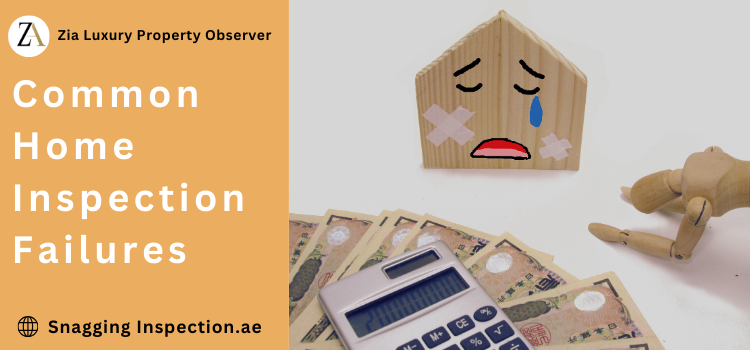When you’re in the process of buying or building a home, a thorough home inspection is one of the most critical steps in ensuring that your investment is sound. However, there are many issues that can cause a home to fail an inspection, leading to costly repairs and potential deal breakers. Let’s explore the common things that fail a home inspection, the signs of each failure
1. Structural Issues: Walls, Ceilings, and Floors
One of the primary things that can fail a home inspection is structural issues with the walls. Cracks in the walls, especially those wider than 1/4 inch, are a red flag. These cracks can indicate foundational problems, which can be expensive to fix.
Ceiling issues are another common reason for a failed home inspection. Water stains, sagging, or cracks can indicate leaks or structural damage.
Floors that are uneven, sagging, or show signs of water damage can also lead to a failed inspection. These issues often point to deeper structural problems that need immediate attention.
Signs of Failure
- Large cracks, particularly diagonal or stair-step cracks.
- Bulging or leaning walls.
- Uneven gaps between walls and ceilings.
- Water stains, which may indicate leaks from the roof or plumbing.
- Sagging ceilings, a sign of structural weakness or water damage.
- Uneven or sloping floors.
- Soft spots that indicate rot or structural damage.
- Warping or buckling, often a sign of water damage.
2. Electrical System Failures
Electrical issues are a significant concern during a home inspection. Faulty wiring, outdated systems, and inadequate electrical panels can pose serious safety risks, including fire hazards.
Signs of Failure
- Exposed or frayed wires.
- Overloaded electrical panels.
- Outdated or insufficient electrical systems, such as knob-and-tube wiring.
3. Plumbing Problems
Plumbing is another critical area that inspectors scrutinize. Leaks, poor water pressure, and inadequate drainage systems are common plumbing issues that can cause a home to fail an inspection.
Signs of Failure
- Leaks, particularly under sinks, around toilets, and in basements.
- Low water pressure, which may indicate blockages or pipe damage.
- Slow drainage or gurgling sounds, often signs of clogged pipes or sewer issues.
Book your Inspection with us today.
Our expert team is ready to conduct a thorough assessment of your property, identifying any potential issues and providing you with actionable recommendations.
5. Windows and Doors
Windows and doors that don’t function properly can be more than just a nuisance—they can indicate underlying problems with the home’s structure or energy efficiency.
Signs of Failure
- Windows that don’t open or close properly.
- Gaps around windows and doors, leading to drafts.
- Condensation between double-paned windows, a sign of seal failure.
4. Roofing Issues
The roof is one of the most expensive components of a home, and any significant issues here can lead to a failed inspection. Inspectors will look for signs of wear and tear, damage from weather, and improper installation.
Signs of Failure
- Missing or damaged shingles.
- Water stains on ceilings, indicating leaks.
- Sagging rooflines, a sign of structural issues.
6. HVAC System Failures
Fixtures and fittings, such as sinks, faucets, and toilets, are often overlooked, but they can cause a home to fail an inspection if they are outdated or not functioning correctly.
Signs of Failure
- Leaky faucets or toilets.
- Corroded or outdated fixtures.
- Low water pressure from fixtures.
7. Plumbing Fixtures and Fittings
Heating, Ventilation, and Air Conditioning (HVAC) systems are essential for maintaining a comfortable living environment. A malfunctioning HVAC system can lead to a failed inspection due to energy inefficiency or health hazards.
Signs of Failure
- Unusual noises from the HVAC system.
- Inconsistent heating or cooling.
- Poor air quality or odors coming from vents.
8. Exterior Issues: Siding, Paint, and Landscaping
The condition of a home’s siding and paint can indicate how well the property has been maintained. Peeling paint or damaged siding can lead to moisture penetration and structural damage.
Proper drainage is crucial to prevent water from damaging the foundation. Poorly graded landscaping can cause water to pool around the home, leading to foundation issues.
Signs of Failure
Peeling or flaking paint.
- Cracked or warped siding.
- Signs of moisture damage or mold.
- Pooling water near the foundation.
- Erosion or poor soil grading.
- Overgrown vegetation damaging the home’s exterior.
9. Fire Safety Concerns
Fire safety is a critical aspect of a home inspection. Issues like outdated or missing smoke detectors, improper fire escapes, and faulty wiring can all lead to a failed inspection.
Signs of Failure
- Missing or non-functional smoke detectors.
- Blocked or inadequate fire escapes.
- Outdated or damaged electrical wiring.
Conclusion:
By understanding the common things that fail a home inspection and taking proactive measures, you can avoid costly repairs and ensure that your new home is safe, sound, and a wise investment. Remember, whether you’re dealing with structural issues, plumbing problems, or electrical faults, the key to a successful inspection lies in preparation and attention to detail.


